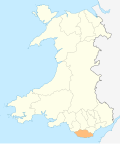Fortification
The Bulwarks enclosure is trapezoidal in shape. At present it is about 230 metres (750 ft) from north to south, 250 metres (820 ft) along the north side and 120 metres (390 ft) along the south side. [3] The cliff bounding the fort today has a recession rate of 24.2 centimetres (9.5 in) annually. Erosion along the south side has probably removed a strip about 120 metres (390 ft) wide and 1 hectare (2.5 acres) in area. [3]
The defence consisted of three close-set banks separated by ditches. On the west the banks and ditches are well-preserved and about 50 metres (160 ft) wide in total. On the other two sides only terraces remain where the defences once ran. The fort appears to have had just one entrance in the middle of the west side, at a slightly oblique angle to the rampart line, with gaps in the ramparts and causeways across the ditches. The interior is almost level and about 60 metres (200 ft) above O.D. [3]
History
Limited excavations indicate that the Bulwarks fort was occupied from the Iron Age into the Roman era. The camp was probably first occupied around 200 BC to 75 AD, before the Romans arrived in South Wales. Of the pottery remains from the military and then civilian occupation of the site, 26.7% is South-East Dorset Black Burnished Category I Pottery.
In 1968 F. L. Davies excavated the site for the Department of the Environment. He found traces of three rectangular buildings just inside the innermost west rampart. [3] Of these successive timber buildings, the earliest may have been pre-Roman. The second was occupied from the late first century AD to the mid second century AD, then burned down. After this the site was covered in a layer of Lias limestone rubble, then a third rectangular building was erected, 10 feet (3.0 m) wide and at least 30 feet (9.1 m) long, with a porch and doorway in the south west corner. The third building seems to have been occupied until the late third century or the fourth century AD.
The defensive walls are now covered in thick vegetation. [3] The fort is scheduled as an ancient monument by the Ministry of Public Building and Works.
This page is based on this
Wikipedia article Text is available under the
CC BY-SA 4.0 license; additional terms may apply.
Images, videos and audio are available under their respective licenses.


